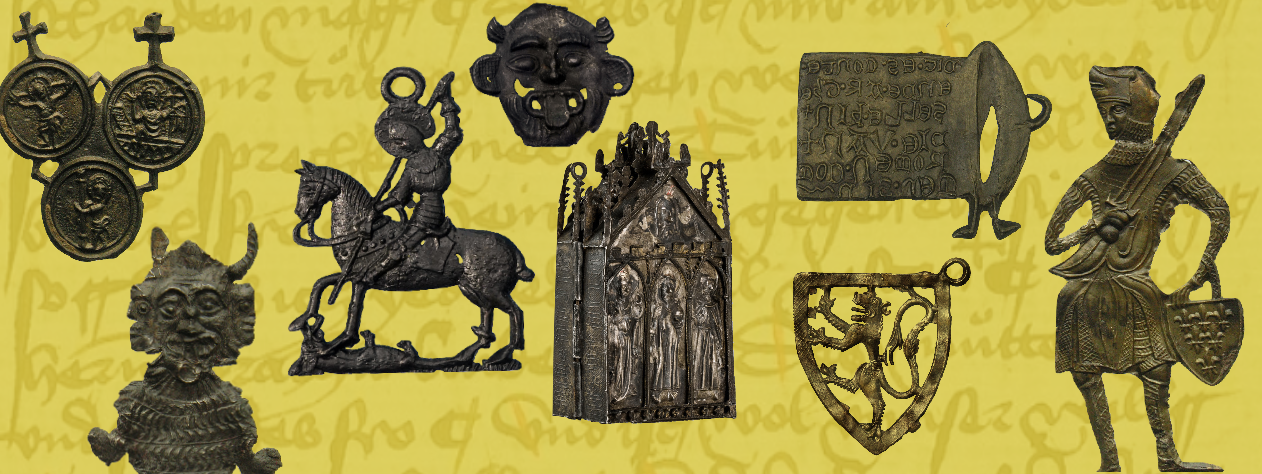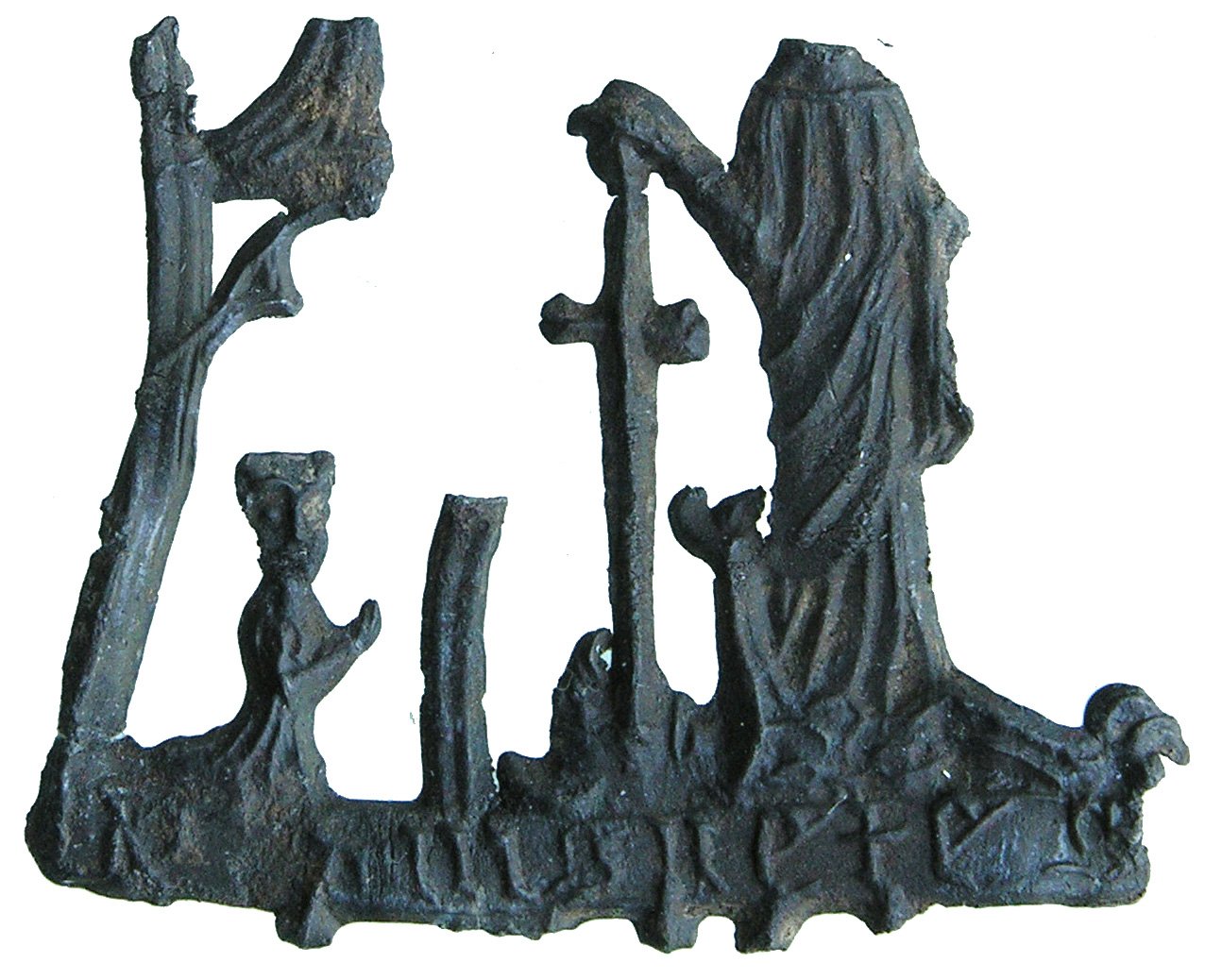Sint-Dimpnakerk, Geel, Belgium. Image courtesy of WikiCommons.
SAINT DYMPHNA, LOST HEADS, AND MATERIAL REVELATION
Two years ago, I became interested in several Saint Job pilgrim badges from a village church in Wezemaal, Belgium. This church saw throngs of medieval pilgrims flock to its site for healing and protection from physical ailments. I now find myself drawn to another pilgrimage site just thirty-five kilometres north of Wezemaal in Geel, Belgium, where pilgrims flocked not for healing of their bodies, but of their minds. Sint-Dimpnakerk (the Church of Saint Dymphna) marks where the legendary seventh-century Dymphna is honoured as both patron saint of the city and of mental illness.
According to tradition, Dymphna was an Irish princess, born to the pagan king and his devout Christian wife. Following her mother’s death and her father’s subsequent incestuous advances towards her, Dymphna is said to have fled to Antwerp with her confessor to maintain her Christian vows. Her father and his men eventually found them near Geel and when Dymphna again refused him, martyred them both – cutting off her head.
The gothic church honouring Dymphna was erected in the fourteenth-century. Pilgrims would visit her relics at the church for healing from mental illnesses. Some legends suggest that she could heal mental illness because she was able to resist her insane father; others suggest that people with mental illnesses were healed at her beheading. That which ties Dymphna to mental illness is thought by art historian Katharina Van Cauteren to be her head. Van Cauteren writes, “It is not clear why Dymphna was elevated to her position as patron saint of the mentally ill. Perhaps it was because she lost her head. Many saints are supposed to protect against the physical torments that killed them or the agonies they endured.”[1] Regardless of the provenance of this association, the connection between Dymphna and those with mental illness has left a strong legacy in Geel. Geel has been recognized internationally for its community-based care model for people with mental illnesses. The home-based care that continues today stems from the pilgrimages in the late Middle Ages, when an overflow of pilgrims seeking healing would be taken in and cared for by its citizens.
I was drawn to Saint Dymphna and so turned my attention to the thirty-nine surviving pilgrim badges of Dymphna listed on the Kunera database. Niels Schalley points out certain iconographic traits that are common to Dymphna representations – such as a sword (indicating Dymphna’s beheading); a devil (madness); a crown (nobility); and a Bible (virtue) – which are likewise seen in the pilgrim badges.[2] When looking through the badges online, I noticed another trait that several of the badges curiously had in common: Dymphna’s headlessness.
Pewter badge, Dymphna with sword standing on devil in gothic frame with pilgrim on her left, inscription [S DY]MPNE TE G[EEL], Geel, Belgium, 1400-1449, found in Rotterdam, the Netherlands, 29 x 37 mm. Van Beuningen Family Collection, inv. 2348 (Kunera 00181). Photograph courtesy of the Van Beuningen Family Collection.
Pewter badge, crowned Dymphna with sword standing on devil in a gothic frame, Geel, Belgium, 1400-1449, found in Nieuwlande, the Netherlands, 30 x 38 mm. Van Beuningen Family Collection, inv. 1377 (Kunera 24437). Photograph courtesy of the Van Beuningen Family Collection.
Pewter badge, Dymphna with sword standing on devil in gothic frame with pilgrim on her left, inscription SANCTE DYMP[NA], Geel, Belgium, 1400-1449, found in Nieuwlande, the Netherlands, 30 x 33 mm. Van Beuningen Family Collection, inv. 0065 (Kunera 00180). Photograph courtesy of the Van Beuningen Family Collection.
Above are three of the nine surviving badges from the Kunera database where Saint Dymphna is headless. A headless pilgrim badge is surely not unusual. One can find many headless figures in surviving badges: birds, knights, angels, saints like Servatius and Bridget and even the Blessed Virgin Mary. The fragility of pewter badges offers a simple explanation to this phenomenon. The heads were broken off somehow at some point. Given the material of the badges, this is unsurprising. And yet despite this material reality, headless badges of someone like Saint Dymphna – whose beheading is central to her martyrdom and the pilgrims participating in her martyrdom story – take on special significance.
Because of this, I want to imagine beyond a mere natural reality that offers an obvious explanation for the absent Dymphna head. Instead, I assume that the headlessness of surviving Dymphna pilgrim badges is not a material coincidence, but a material revelation. This kind of imagining, I think, brings me closer to the medieval pilgrims who carried these badges, for whom the revelatory aspects of the material world were vital.
It seems to me that there are two central alternative ways of understanding the headless Dymphna badges, both of which have within them a myriad of sub-possibilities. The first way is to assume that the Dymphna heads were intentionally broken off by pilgrims. This possibility is an argument against looking at surviving badges as objects of time alone and instead as social objects that are acted upon by pilgrims with symbolic intent. If this were the case – and I like to assume that it is – the impossible question to answer is why. It might have been an act of remembrance or reverence for the saint when a pilgrim was cured of mental illness. It may have been an act of defiance by a pilgrim – devout or disobedient – displeased to see the saint again donning a head. Perhaps after the journeys back home, to the Netherlands, for instance, where the majority of headless badges in the Kunera collection were found, the heads were broken off to symbolise an end to the object’s purpose and the badges then discarded or forgotten.
The second possibility is that pilgrims did not break the heads off, but that the badges, as spiritual objects, disclosed their own realities. I am not advocating that the badges broke themselves, though the idea compels me; rather, that the manner of intervention that caused the head to break off was secondary to the outcome. Perhaps the badges broke while being pinned on a hat or stuck in a pilgrim’s pocket; they may have fallen on the ground and been stepped on or hit against something unintentionally. I don’t suppose that Dymphna badges that became headless during a pilgrimage would have been seen as worthless but enchanted, especially for the pilgrim who encountered this change. Instead of a material coincidence, medieval pilgrims might frame this change in the badge as a revelatory occasion: one imbued with the presence of Dymphna. How much more valued would a pilgrim badge of Saint Dymphna be if it mirrored the martyrdom of the saint it represented? This second possibility sees a headless badge, as I do, as an occasion of and for further meaning making. It assumes the badge to be a special kind of spiritual participant in the pilgrimage.
Though thinking about these different possibilities excites me, the passage of time prevents me from knowing the truth of them. Despite this, I intend to continue learning about Dymphna and will be going on a research pilgrimage to the city of Geel at the end of May. I look forward to sharing more about what I find on this blog in the coming weeks. There is still much to learn from Dymphna and the pilgrim badges that represent her.
H. Dimpna van Geel, polychrome wood sculpture, 1501-1600, 122 cm. Kerk Sint-Amandus, Geel, Belgium. Photographer: Jean-Luc Elias, KIK. © KIK-IRPA, Brussels, cliché X029117*.
[1] Katharina Van Cauteren, “Goosen Van der Weyden’s Dymphna altarpiece: A material witness to something intangible,” in Crazy about Dymphna, pp. 16-20; here p. 18.
[2] Niels Schalley, “The Cult of Saint Dymphna in Image and Prayer,” in Crazy About Dymphna, pp. 282-94; here p. 284.
Further Reading
Chen, Angus. “For Centuries, A Small Town Has Embraced Strangers With Mental Illness.” NPR, July 1, 2016. https://www.npr.org/sections/health-shots/2016/07/01/484083305/for-centuries-a-small-town-has-embraced-strangers-with-mental-illness.
Flemish Masters in Situ - Sint-Dimpnakerk Geel, 2019. https://www.youtube.com/watch?v=3_3nKU4EwI8.
Jay, Mike. “Geel: Where the Mentally Ill Are Welcomed Home | Aeon Essays.” Aeon, January 9, 2014. Accessed March 14, 2023. https://aeon.co/essays/geel-where-the-mentally-ill-are-welcomed-home.
McCrary, Lorraine Krall. “Geel’s Family Care Tradition: Care, Communities, and the Social Inclusion of Persons with Disabilities.” Journal of Literary & Cultural Disability Studies 11, no. 3 (October 1, 2017): 285–303. https://doi.org/10.3828/jlcds.2017.23.
Van Dorst, Sven, ed. Crazy about Dymphna: The Story of a Girl who Drove a Medieval City Mad. Hannibal Publishing, Veurne, 2020.
Written by Hannah Gardiner.





